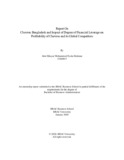Chevron Bangladesh and impact of degree of financial leverage on profitability of Chevron and its global competitors
Abstract
The financial analysis shows Chevron Corporation stock yields lower expected return than the market at higher levels of risk. Moreover, the stocks are overvalued. Ratio analysis shows an overall satisfactory performance against its competitors in terms of leverage and profitability.
The study models the relationship of profitability; measured by return on asset; and degree of financial leverage while controlling for degree of operating leverage and degree of total leverage. The model is established using Pooled Model and Individual Effects Model in STATA on secondary accounting data. Although the results are inconclusive as number of individual observations is small (only 3 companies), it provides crucial insights. As DFL increases ROA decreases for all three models. The Fixed Effect Model (one of the Individual Effects Model) can explain 18.69% variation in return on assets and is most intuitive. It conforms to the existing theory that in the long-run, the only benefit of leverage that a firm enjoys is tax shield. Thus, capital structure decision should optimize level of debt financing to minimize the effects of taxation especially for companies like Chevron Corporation who pay nearly a third of their operating income in effective tax.

